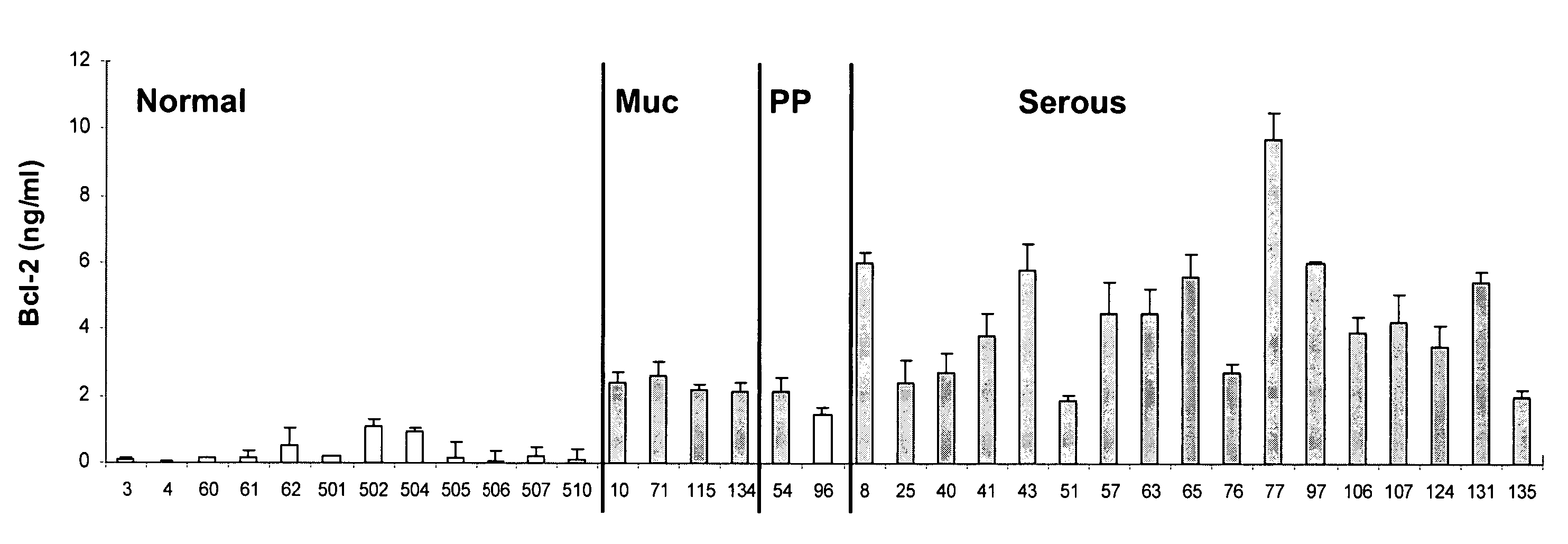Detection of cancer by elevated levels of BCL-2
a cancer marker and elevated level technology, applied in the field of detection of cancer by elevated levels of bcl2, can solve the problems of insufficient cancer markers, few markers have been shown to be helpful in this way, and the level of cancer markers is usually too high, so as to achieve the effect of reducing the urinary level of bcl-2
- Summary
- Abstract
- Description
- Claims
- Application Information
AI Technical Summary
Benefits of technology
Problems solved by technology
Method used
Image
Examples
example 1
Urinary Bcl-2 Levels are Elevated in Ovarian Cancer Patients
[0173] Urine and blood were collected from 90 individuals with samples collected from normal controls (N=21), women with benign disease (N=35) and women with ovarian cancer (N=34). The latter category consisted of women diagnosed with endometriod (N=1), mucinous (N=7) as well as serous ovarian cancer (N=24) and primary peritoneal cancer, which is often related to ovarian cancer, (N=2). The samples collected from women with benign gynecologic disease consisted of women with benign cystic teratomas (N=2), simple cysts (N=10), leiomyomas (N=8), polycystic ovarian disease (N=1), ovarian adenofibromas (N=4), mucinous cystadenomas (N=2) and serous cystadenomas (N=8). Though this cohort comprises a small pilot study, it is representative of a typical clinical practice with regards to histology, grade and stage distribution.
[0174] To determine the potential suitability of urinary Bcl-2 levels as a new molecular marker for ovarian...
example 2
Urinary Bcl-2 in Patients with Benign Gynecological Disease is not Elevated
[0177] ELISA measurement of urinary Bcl-2 from 35 women with benign gynecologic disease (urine collected just prior to patient's treatment) indicated Bcl-2 levels averaging 0.02 ng / ml with no samples>1.8 ng / ml Bcl-2, as shown in FIG. 8A. These benign diseases included benign teratomas, simple cists, leiomyomas, polystronic ovary, fibromas, and adenomas. These values were similar to normal controls, but significantly less than ovarian cancer samples suggesting that elevated urinary Bcl-2 levels greater than 1.8 ng / ml was associated with ovarian cancer.
[0178] The Kruskal-Wallis test was used to test the normal distribution of the data. Since the ‘normal’ group failed to meet normal distribution, likely due to small sampling number, the differences between groups were analyzed by the Mann-Whitney U-test. The results indicated no significant difference between normal and benign (p90%.
example 3
Urinary Bcl-2 does not Correlate with Patient Age or Tumor Size
[0179] Comparison of clinical parameters suggested that urinary Bcl-2 levels did not relate with patient age (see FIG. 5). Though the age range and average age of normal controls (29-81 yr, average 48.5±S.D. 12.7 yr) and women with benign gynecologic disease (28-84 yr, average 55.9±S.D. 13.9 yr) was somewhat lower that that of women with ovarian cancer (26-92 yr, average 62.2±S.D. 13.8 yr), the differences were not statistically significant in this study. Similarly, urinary Bcl-2 levels did not correlate with tumor size measured at debulking surgery (FIG. 6), ranging from microscopic to >10 cm and may reflect biologic variation between individuals or variation of tumor composition.
PUM
| Property | Measurement | Unit |
|---|---|---|
| Concentration | aaaaa | aaaaa |
| Concentration | aaaaa | aaaaa |
| Concentration | aaaaa | aaaaa |
Abstract
Description
Claims
Application Information
 Login to View More
Login to View More - R&D
- Intellectual Property
- Life Sciences
- Materials
- Tech Scout
- Unparalleled Data Quality
- Higher Quality Content
- 60% Fewer Hallucinations
Browse by: Latest US Patents, China's latest patents, Technical Efficacy Thesaurus, Application Domain, Technology Topic, Popular Technical Reports.
© 2025 PatSnap. All rights reserved.Legal|Privacy policy|Modern Slavery Act Transparency Statement|Sitemap|About US| Contact US: help@patsnap.com



